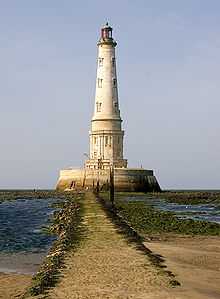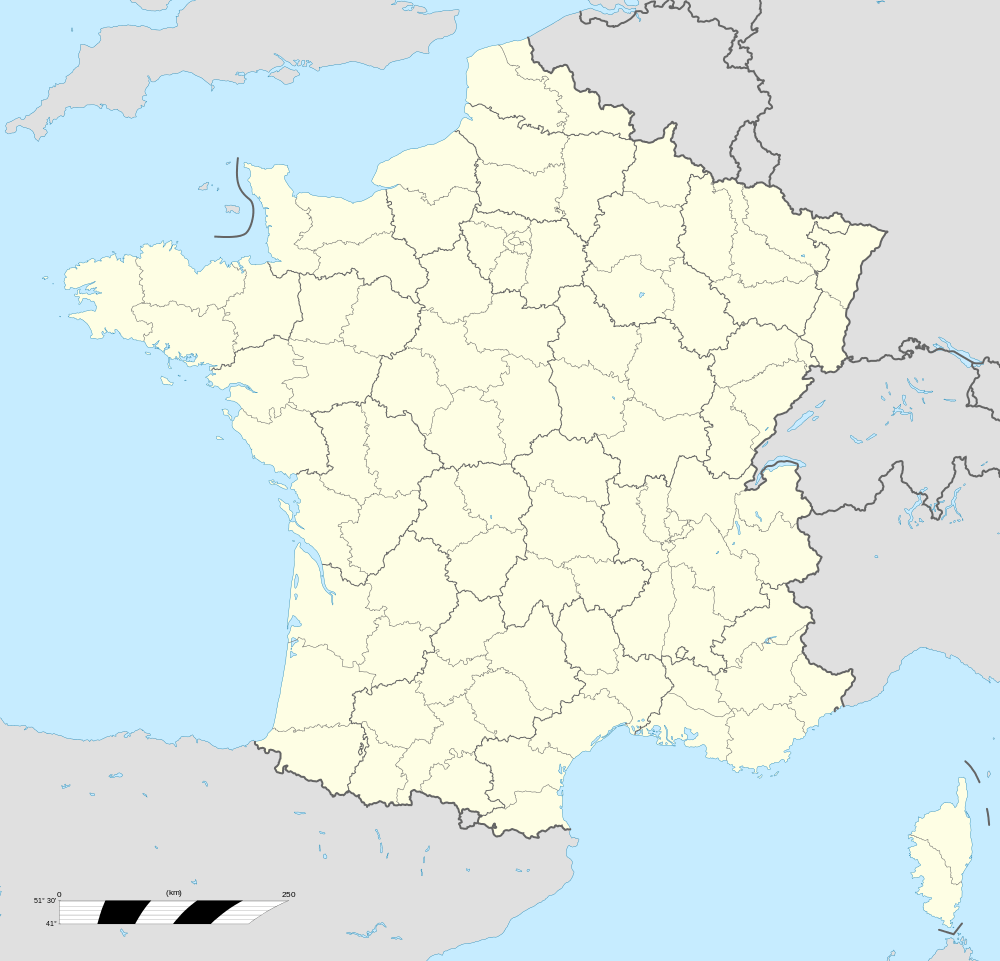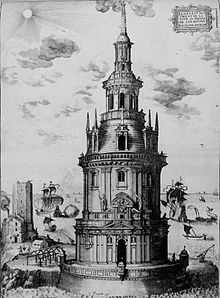Cordouan Lighthouse
 Cordouan Lighthouse, November 2006 | |
 | |
| Location | Gironde, France |
|---|---|
| Coordinates | 45°35′10.84″N 1°10′24.48″W / 45.5863444°N 1.1734667°WCoordinates: 45°35′10.84″N 1°10′24.48″W / 45.5863444°N 1.1734667°W |
| Year first constructed | 1611 |
| Year first lit | 1788 |
| Foundation | cylindrical 3-story base |
| Construction | Stone |
| Tower shape | Conical, three galleries |
| Markings / pattern | light gray, darker gray band and top |
| Height | 223 feet (68 m) |
| Focal height | 197 feet (60 m) |
| Original lens | First order Fresnel lens |
| Range | white 22 nautical miles (41 km; 25 mi) red/green 18 nautical miles (33 km; 21 mi) |
| Characteristic | Occ. W R or G (depending on direction) 12s |
| Admiralty number | D1300 |
| NGA number | 13-1480 |
| ARLHS number | FRA-007 |
Cordouan lighthouse is an active lighthouse located 7 km at sea, near the mouth of the Gironde estuary in France. At a height of 223 feet (68 m) it is the tenth tallest "traditional lighthouse" in the world.[1]
The Tour de Cordouan, the 'Patriarch of Lighthouses', is by far the oldest lighthouse in France. It was designed by leading Paris architect Louis de Foix, and is something of a Renaissance masterpiece, an amalgam of royal palace, cathedral and fort. Started in 1584 and finished in 1611, it still stands today.
History
Small beacon towers had existed on the islet since 880, but the first proper structure was implemented by Edward, the Black Prince, since Guienne was then an English province. It was 48 feet (15 m) high, with a platform on top where a wood fire could be kept burning, and manned by a religious hermit. Passing ships paid two groats to pass - the first known instance of lighthouse dues. In addition to the tower, a small chapel was built on the islet. However, by the second half of the 16th century the tower had fallen into disrepair and the hazard to navigation threatened the Bordeaux wine trade. This led to the construction of the current Tour de Cordouan.
Design

De Foix first built a round base 135 feet (41 m) in diameter and 8 feet (2.4 m) high to take the onslaught of the waves. Within it was a cavity 20 feet (6.1 m) square for storing water and other supplies. Above it were constructed four storeys of diminishing size. The ground floor consisted of a circular tower 50 feet (15 m) in diameter, with apartments for four keepers around its inner wall. In the centre was richly decorated entrance hall 22 feet (6.7 m) square and 20 feet (6.1 m) high. The second storey was the King's Apartment, consisting of a drawing room, anteroom and a number of closets. The third storey was a chapel with a domed roof notable for the beauty of its mosaic. Above this was secondary lantern, and above that the Lantern itself. This was 162 feet (49 m) above the sea and visible 5–6 miles away, the original light being provided by burning oak chips in a metal container.
Throughout the building, de Foix took as much trouble with the decor as with the durability of the building, and on every floor was a profusion of gilt, carved work, elegantly arched doorways and statuary.

Extension
The first parabolic lamps were added in 1782, but the lighthouse was now in very poor condition. Sailors also criticized the lack of height of the light. Major renovations were needed. They were carried out from 1782 to 1789 by the engineer Joseph Teulère who suggested enhancing the 30-meter tower, retaining the ground floor and two floors, in the Louis XVI style whose simplicity contrasted with the wealth of the lower floors, which retained their Renaissance decoration.
In 1790, after the lighthouse was raised 60 meters above the highest tides, Teulère devised the first turning lighting dish. It consisted of Argand lamps turned by a machine built by a watchmaker in Dieppe. The fuel was a mixture of whale, olive and rapeseed oil.
The first Fresnel lens rotating system, the invention of Augustin-Jean Fresnel, was installed in Cordouan in 1823. Three concentric lamp wicks, supplied to rapeseed oil by means of a suction and force pump, were placed in the focal plane of the apparatus.
It was restored in 1855 and made a historical monument in 1862, at the same time as Notre-Dame de Paris. The Fresnel lens was replaced by the present lens in 1854.
See also
References
- ↑ Rowlett, Russ. "The Tallest Lighthouses". The Lighthouse Directory. University of North Carolina at Chapel Hill.
- Rowlett, Russ. "Lighthouses of France: Aquitaine". The Lighthouse Directory. University of North Carolina at Chapel Hill.
- List of Lights, Pub. 113, The West Coasts of Europe and Africa, the Mediterranean Sea, Black Sea and Azovskoye More (Sea of Azov) (PDF). List of Lights. United States National Geospatial-Intelligence Agency. 2009. p. 23.
This article incorporates text from a publication now in the public domain: Wood, James, ed. (1907). "article name needed". The Nuttall Encyclopædia. London and New York: Frederick Warne.
External links
| Wikimedia Commons has media related to Cordouan lighthouse. |
- Cordouan lighthouse official website : virtual visit, 3D restitution, more than 800 documents about Cordouan
- Cordouan Information (French)